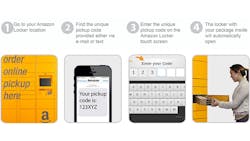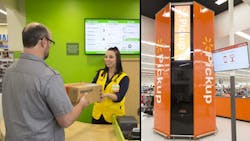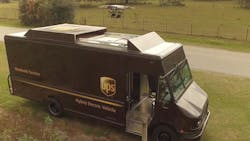Retail, e-tail seek ever-faster, most convenient delivery
Retail and e-commerce giants continue to jockey for a better — or at least catchier — way to get goods and grub into customers' hands. And it's specifically that hand-off they're focused on: the last-mile innovation wars have been honing in lately on the last foot or so.
In-store pickup for items purchased online is nothing new, but the methods of delivery and time it takes to get things have seen some brainstorming this year. The latest was Amazon's announcement yesterday it's launching Instant Pickup for Prime and Prime Student members, initially at five locations in Los Angeles, Atlanta, Berkeley, CA, Columbus, OH and College Park, MD.
The service lets Amazon app users order from an expanded vending machine palette of food, drinks, personal care items, technology accessories like phone chargers and Amazon devices including the Echo and Kindle e-readers. Customers can then pick them up "in two minutes or less" out of self-service lockers, according to Amazon, and the company is looking to expand the service in the coming months.
The announcement follows reports by Reuters and others last week that the e-commerce powerhouse is exploring using U.S. military technology that would allow it to deliver unrefrigerated ready-made meals via its Amazon Fresh grocery service. Such an endeavor could complement Amazon's purchase of Whole Foods Market earlier this summer (although "pre-packaged" and "whole foods" seem at odds).
Meanwhile, Target Corp. wants in on local delivery shake-ups as well and announced Monday its purchase of Grand Junction, which provides a software platform connecting retail, third-party logistics and distribution companies.
"This acquisition is part of Target's ongoing efforts to strengthen Target's supply chain to provide greater speed, reliability and convenience for guests," stated Arthur Valdez, executive vice president and chief supply chain and logistics officer at the company. Grand Junction said it's working with the retailer now on a same-day delivery pilot at the Target in New York's trendy Tribeca neighborhood.
Walmart also has offered up some new takes on vending machines, and very large ones at that. The company recently expanded piloting of its Pickup Tower to more store locations, and the machines let users scan in their order code. Having been loaded by store employees, the massive towers deliver the items to customers using a conveyor system inside.
The idea is to carve out that time it would've taken to wait in a customer service line and have an employee hand over an order, automating that part of the process instead. Similarly, Walmart's grocery pickup option allows customers to order their supermarket list, pull up to a store and have the items loaded in their vehicle, taking the legwork out of the shopping process.
In almost a reverse-Uber-type functionality, Walmart app users can signal the store that they're on their way so location employees can be sure their orders are ready when they arrive. The retailer also has been testing out sending local orders home with employees to deliver where routes and logistics make sense — another nod to the ride-sharing concept.
It's not only retail stores that are focusing on these types of higher-convenience, time-saving innovations and hoping they'll take off. Google patented a self-driving delivery truck concept last year, for instance, that would shuttle orders to customers who would then retrieve them out of an array of lockers on the vehicle, perhaps by entering a unique code.
Also not to be overlooked are efforts to develop and find real-world uses for delivery drones by the likes of Amazon and Workhorse Group, the latter of whom has actually piloted last-mile drone delivery with UPS and on its own to see if the technology can extend the capabilities of the delivery driver.
Time will tell if these sorts of last-mile — or, again, last-foot — concepts and efforts will have meaningful impact or will end up simply as headline generators that fizzle out with little effect. But it's also the time factor that businesses in retail, e-commerce and distribution clearly are targeting, looking to allow either customers or delivery drivers to do more, and in many cases by freeing them up using machines of some kind.
Mark Ibbotson, executive vice president of central operations for Walmart U.S., may have put it best in a blog post back in April that touched on the Pickup Towers: it's ultimately the consumers who'll decide. "Some of what we're doing will make its way to all our stores; others we'll simply learn from and use to develop the next great thing.
"The only guarantee is that we'll let you tell us what works best," he wrote. "The future of shopping is ultimately up to you."
On a final note, regardless, consumers are becoming more and more used to faster delivery of their online or app-driven orders at the locations most convenient to them — and in just about every case, free of charge. And that's sure to challenge the trucking and logistics industries behind such conveniences going forward.
About the Author
Aaron Marsh
Aaron Marsh is a former senior editor of FleetOwner, who wrote for the publication from 2015 to 2019.


